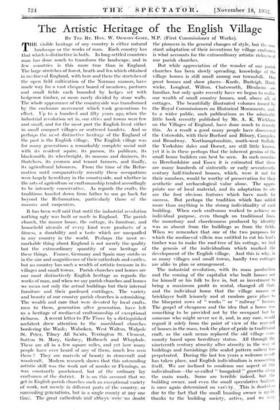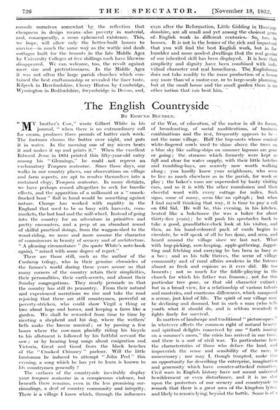The Artistic Heritage of the English Village
M.P. (First Commissioner of Works). By THE RT. HON. W. ORMSBY-GORE, IIIHE visible heritage of any country is either natural landscape or the works of man. Each country has that which is distinctive in both. In long-settled -countries man has done much to transform the landscape, and in few countries is this more true than in England. The large stretches of forest, heath and fen which obtained in mediaeval England, with here and there the stretches of the open field cultivation of the Norman manors, have made way for a vast chequer board of meadows, pastures and small fields each bounded by hedges set with hedgerow timber, or more rarely divided by stone walls. The whole appearance of the countryside was transformed by the enclosure movement which took generations to effect. Up to a hundred and fifty years ago, when the industrial revolution set in, our cities and towns were few and small, and for the most part the English lived either in small compact villages or scattered hamlets. And so perhaps the most distinctive heritage of the England of the past is the English village. The English village was for many generations a remarkably complete social unit with its resident squire, its parson, its publican, its blacksmith, its wheelwright, its masons and drainers, its thatchers, its yeomen and tenant farmers, and finally, its agricultural labourers. From the time of the Refor- mation until comparatively recently these occupations were largely hereditary in the countryside, and whether in the arts of agriculture or craftsmanship tended accordingly to be intensely conservative. As regards the crafts, the traditions handed down from father to son go back far beyond the Reformation, particularly those of the masons and carpenters.
It has been well said that until the industrial revolution nothing ugly was built or made in England. The parish church, the manor house, the cottage, its furniture, and household utensils of every kind were products of a fitness, a durability and a taste which are unequalled in any country in the world. Perhaps the most re- markable thing about England is not merely the quality but the extraordinary quantity of our heritage Of these things. France, Germany and Spain may outdo us in the size and magnificence of their cathedrals and castles, but no country has such a wealth of artistic treasure in its villages and small towns. Parish churches and homes are our most distinctively English heritage as regards the works of man, and when we say parish churches and homes we mean not only the actual buildings but their internal furniture and their gardened curtilages. The variety and beauty of our country parish churches is astonishing. The wealth and care that were devoted by local crafts- men to them, generation after generation, have left us a heritage of mediaeval craftsmanship of exceptional richness. A recent letter to The Times by a distinguished architect drew attention to the marshland churches bordering the Wash ; Walsoken, West Walton, Walpole St. Peter, Tilney All Saints, Terrington St. Clement, Sutton St. Mary, Gedney, Holbeach and Whaplode. These are all in a few square miles, and yet how many people have ever heard of any of them, much less seen them ? They are marvels of beauty in stonecraft and woodcraft. Modern research shows that this astounding artistic skill was the work not of monks or. Flemings, as was constantly proclaimed, but of the ordinary lay craftsmen of the district. It is on this account that we get in English parish churches such an exceptional variety of work, not Merely in different parts of the country, or succeeding generations, but in a single county at finy one trine: 'The-treat Cathedrals --Eird-abb-eyr Vete—no doubt ' the pioneers in the general changes of style, but the eon. stant adaptation of their inventions_ by village craftsmen is what accounts for the extraordinary artistic richness of our parish churches.
But while appreciation of the wonder of our parish churches has been slowly Spreading, knowledge of the village homes is: still small among our townsfolk. Our great houses and show places—Knole, Burleigh, wicke, I,ongleat, Wilton, Chatsworth, Blenheim--are familiar, but only quite recently have we begun to realize our wealth of small country houses, and, above all, of cottages. The beautifully illustrated volumes issued by the Royal Commissioner S on Historical Monuments, and, to a: wider public, such -publications as the admirable little book recently published by Mr. A. K. Wickham on the Villages of England, have done much to remedy this. As a result a good many people have discovered the Cotswolds, With their Burford and Bibury, Campden and Broadway. . Northamptonshire, south-west Suffolk, the Yorkshire dales and Dorset, are still little known, yet it is in these perhaps that the inherent genius of the small house builders can best be seen. In such counties as Herefordshire and Essex it is estimated that _there are many hundreds of sixteenth- or early seventeenth- century half-timbered houses, which, were it not for their numbers, would be worthy of preservation for their aesthetic and archaeological value alone. The apprii- priate use of local material, and its adaptation to site are the first obvious features which have made for success. But perhaps the tradition which has added more than anything is the strong individuality of each building. When each craftsman worked to achieve an individual purpose, even though on traditional lines. the monotony and cheerlessness produced by identity was as absent from the buildings as from the fields. When we remember that one of the two purposes for which the mediaeval villein was entitled to cut his lord's timber was to make the roof-tree of his cottage, we find the genesis of the individualism which marked the development of the English village. And this is why, in so many villages and small towns,, hardly. two .cottages are alike in plan or arrangement.
The industrial revolution, with its mass production and the coming of the capitalist who built houses not for himself or his folk to live in, but as investment to bring a maximum profit in rental, changed all that, and the individual home that the village mason or bricklayer built leisurely and at random gave place to the blueprint rows of " works" or " railway " houses. The gospel of cheapness and the idea that a house was something to be provided not by the occupant but by someone who might never see it, and, in any case, would regard it solely from the point of view of the rent-roll of houses in the mass, took the place of pride in traditional craft, as the cash nexus replaced the old village com- munity based upon hereditary Status. All through the nineteenth century atrocity after atrocity in the way of buildings and furnishings (the sealed pattern suites) was perpetrated. During the last fen years a welcome revolt has taken place; and English individualism is reasserting itself. We are inclined to condemn one aspect of this individualism—the so-called " bungaloid growths along the main roads. Some are "terrible' indeeic, but the building owner, 'and even the small speculative builder. is once again determined On varlc-ty.. This is doubtless due to the fact that the small building owner is again. thanks to. the 'building society, active, and we pia)" console ourselves somewhat by the reflection that cheapness in design .means-also. poverty 4n-- material,- and, consequently, a more .ephemeral existence. _. This, we hope, will allow only the better-built houses to- survive—in much the same wair as the wattle Lid daub, cottages built for the tenants _in the late .Middle Ages _ by University Colleges at -five shillings each have likewise disappeared. We can welcome, too, the revolt against mere size and pretentiousness. In the .Middle stkges. it was not often the• large parish churChes which con- tained the best craftsmanship or revealed the finer taste. Kilpeck in Herefordshire,- Cherry Hinton by Cambridge,. Wymington in Bedfordshire, Svi-ymbridge in Devon, and, even after the ReforKriation, Little. Gidding in Hunting. donshirerare all small and- yet among-the-choicest gems of- English _work . in - different centuries.-- So, -too,• houses. It is not in the _honks of the rich and Important that you will find the best English work, but in far _humbler and more _modest .dwellings,that the real genius of our inherited skill has been displayed. J.t. is. here that _simplicity and dignity jaye been 'combined with indi. vidual character and real hoMeline9.Th Englishman —do-es not take- readily to the Mass production of a house any more than-of a Motor-car, Or to large-scale:plarining, but at the Small "house and the small garaeii..there is no other atioii that eau- _ .

































































 Previous page
Previous page